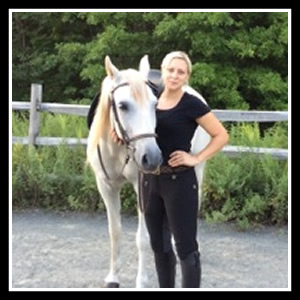Recognizing Back Development

Good morning, this is Will Faerber from Art2Ride and I am here with Jodi Anderson and her horse Casanova. We had a question come in a couple days ago from someone who is working their horse and developing and they wanted to know how to recognize if the horse is developing it’s topline.
It is quite simple because you will see the topline change. By topline I mean the point in the middle of the horse’s ears all the way back to it’s tail. If you look at the horse in the video, you can see how the top of his neck muscles are lit up and the bottom of his neck muscles look very soft, but he’s reaching out from the shoulder. Look how evenly his diagonal pairs are moving (the outside hind leg with the inside foreleg), that is one of the cardinal rules of correct dressage. There is an example of me bringing him all the way up into collection and back down again in one of our other videos on YouTube. Casanova is just coming back from a little time off, so we aren’t going to bring him that high up today.
What you can also see behind his saddle is how filled and round his hindquarters look, there isn’t any big dip behind the saddle. It’s looks like a big ripe round apple, that’s what your horse’s butt should look like. Across the back in the loin area, look how nice he has developed and how nicely swinging that is. Now she is going to let him out into a long stretch and notice how the trot doesn’t change. For those of you riding competitive dressage, this is what the judge is looking for. When you go in and do a stretch that looks like this, you will get 9s. Now she brings him back up into the working trot, and watch those topline muscles actually widen like someone flexing their bicep. You want to think of the topline as one long muscle, you don’t need to know what all the muscles are called in there, but you need to know that they all need to work together. Anytime that you break the horse’s neck over too far in the middle, flex the neck to one side too far or you take the spine out of line it makes it impossible for the horse to perform what you are asking him to do.
Once again, look how filled in this horse is behind the saddle and how round it looks through the loin, that is what a correctly trained horse looks like. So many horses that we see today, you look at their back end and the croup is so high up and the point of the hips is so high up and when you can look you can see a clear triangle. That is a horse that has no real muscle across it’s topline. Look how easily this horse has kept the same steady rhythm and she is not riding with the brakes on. The biggest misconception of dressage is the idea that you hold against the mouth of the horse. Holding against the horse’s mouth is just like if you were to hold your fingers around your bicep and try to flex them, you will find that you won’t be able to flex the muscle and that’s what people do to horses. When you pull against the horse’s mouth, it actually makes it less able to flex across the topline, and that’s how all those horses end up broken in the 3rd vertebrae or even further back in the neck sometimes.
As you watch your horse as days and weeks go by, you should see that filling up. That is why we like to use the Schleese saddles because they come out and check all the time and they will tell you right away whether your horse’s back is developing or not. Keeping track of that is very important for dressage riders. Once again she is going to stretch him all the way down and look how beautifully balanced he has stayed and has never lost his rhythm. Even though this horse’s head and neck are down, he is not on the forehand. When you are watching horses, take your hand and cover up the horse’s neck and see what the rest of the body looks like. When I show you what that looks like with the camera, does it look like he is on the forehand? No, he is swinging deeply underneath his body and look where his neck is. Being on the forehand depends much more on whether the horse is working through the back or not. So often we see these dressage horses that are hollow and flashing their legs up, and if you look closely you will see that they are actually on their forehand. Not to mention that they maintain that horizontal frame where they never really lower, which is also because they never developed correctly as young horses. As horses develop through the stretch, it actually pulls the withers bone up through the withers and gives the horse a much more uphill appearance.
This is Will Faerber and thank you for joining us here on Art2Ride. We hope this helps, and we will see you next time!





Leave a Reply